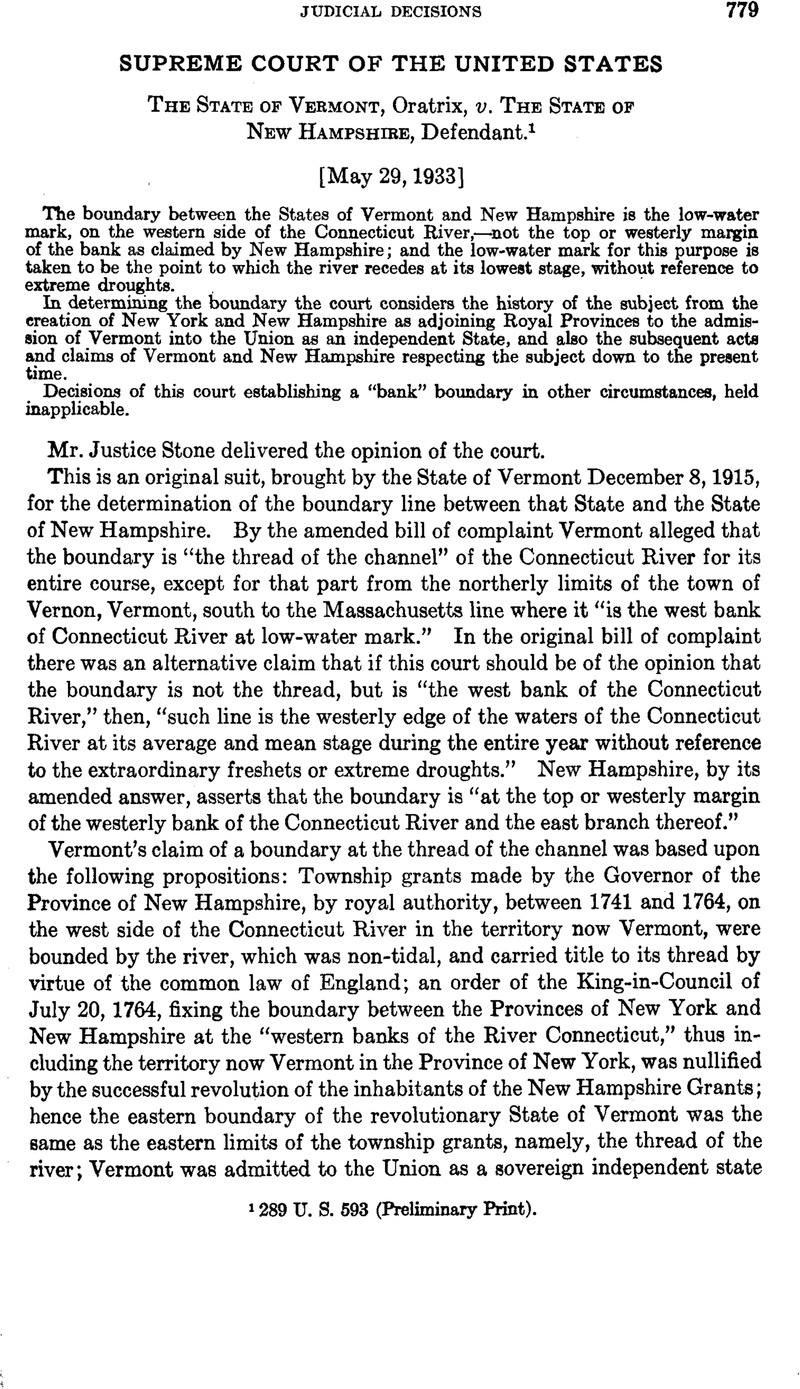No CrossRef data available.
Published online by Cambridge University Press: 12 April 2017

289 U. S. 593 (Preliminary Print).
2 In the Report of the Lords of Trade of 1764 the arguments said to have been advanced by the Governor of New York in support of his boundary claim are, in addition to the language of the Duke of York's Grant, that “the River Connecticut is in all respects the most certain and proper boundary; that it will be more convenient that the lands to the Westward of that river should be included in New York, because Hudson's River being navigable by Vessells of considerable Burthen to Albany, the Trade of that part of the Country will probably center there, to which place the Transportation or Carriage will be much easier, than to the Ports of New Hampshire, and where the Inhabitants are likely to meet with a better Market for their produce; that as the Quit Rent in New Hampshire is but one shilling the hundred Acres, and that of New York, two shillings and six pence, the revenue to your Majesty, if the Lands are settled under New York, will be greater than if granted under New Hampshire; and that there is another Circumstance of great weight at this Juncture, and operating in favor of this proposition, which is, that a great number of reduced Officers have located their Claims to Lands under Your Majesty's Proclamation in this part of the Country, and were willing to take out Grants for the same under the Province of New York, but absolutely decline any application to the Government of New Hampshire.” The Lords of Trade advised that these “arguments urged by the Lieutenant Governor of New York in support of his proposition, appear to us to have great weight, if not absolutely to decide upon the Question; and the only probable inconvenience, that is stated to arise from making the River Connecticut the boundary line between the two Provinces, is the effect which the limitation of New Hampshire, to narrower Limits than is contended for, may have to disable them from making such a provision for its establishment as may be necessary to support it as a separate Government; But as we humbly apprehend, that the great extent of this Province to the Northward leaves sufficient room for much further improvement and Settlement, this objection does not appear to us to be of sufficient weight to counterbalance the convenience and advantage that seems to attend the other proposition; . . . ”
3 Compare the proclamation of Lt.–Gov. Colden of New York of December 28, 1763 declaring “that the province of New York is bounded to the eastward by the River Connecticut” and commanding “all judges, justices and other civil officers within the same, to continue to exercise jurisdiction in their respective functions as far as to the banks of Connecticut River, the undoubted eastern limits of that part of the province of New York, notwithstanding any contrariety of jurisdiction claimed by the Government of New Hampshire.”
4 See letters of Governor Moore to the Earl of Shelboume, June 9, 1767, the Earl of Dunmore to the Earl of Hillsborough, July 20, 1764, Governor Tryon to the Rev. Mr. Dewey, May 19,1772.
5 Upon the argument of the present case it was conceded that the flow of the Connecticut River, always of substantial volume, is confined by precipitous banks extending to or near the water at all normal stages of the river, except for relatively small stretches where the banks are low and overflowed at high water. It does not appear that there are flats of any substantial area lying between the precipitous banks and the water at its lowest stage or that the river has shifted its bed to any material extent at any time. In all these respects the physical characteristics of the Connecticut River differ from those of the Red River, described in Oklahoma v. Texas, supra, 634, 635.
6 The Order-in-Council was specifically referred to in the resolution of Congress of August 7, as having “superseded the pretensions of New Hampshire in favor of New York” and having been “assented to on the part of the former.”
7 Authorization of the town of Stratford, New Hampshire, October 1,1893, for laying out a highway between Stratford and Bloomfield, Vermont; Contract of April 24,1896 between Lyme, New Hampshire and Thetford, Vermont, for the erection of a bridge across the river between the two towns.